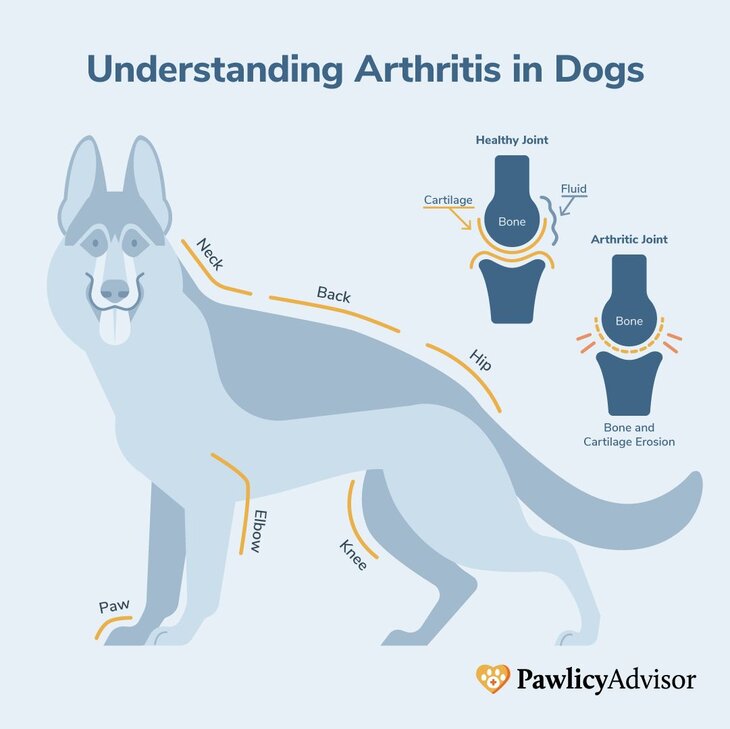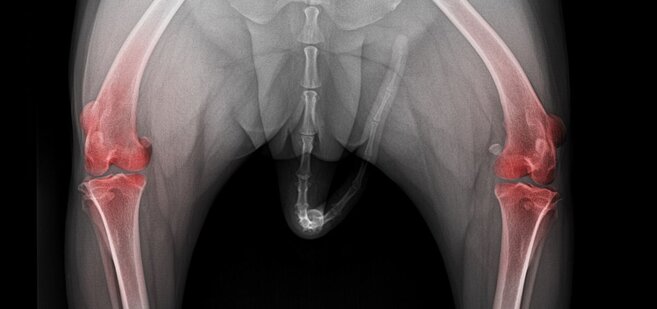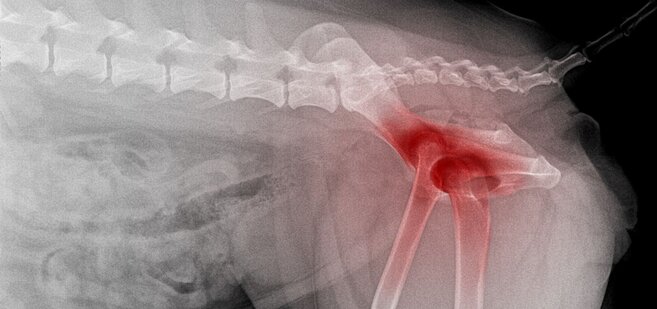Arthritis in Dogs: Managing Risks & Treatment Costs
Arthritis, or degenerative joint disease, is a painful condition that can significantly interfere with your dog's quality of life. The leading cause of disability in pets , an alarming 80% of dogs will contract arthritis, which can manifest at any stage of life. 1
80% of dogs will develop arthritis
Enroll in pet insurance before symptoms occur to ensure they never have to experience pain simply due to the price of treatment.
Pet parents play a crucial role in catching the early stages of arthritis in dogs to alleviate chronic discomfort and prevent impaired mobility .
In this article, we'll discuss dog arthritis symptoms to watch out for, identify leading risk factors, and share tips on how to help a dog with arthritis at home by relieving their joint pain.
We'll also discuss variables that can make managing your pet's condition more or less expensive and show you how pet insurance can help lower your out-of-pocket costs.
- What is degenerative joint disease (arthritis) in dogs?
- What causes arthritis in dogs?
- What dogs are at risk of arthritis?
- What are the signs of arthritis in dogs?
- How much does it cost to treat arthritis in dogs?
- Does pet insurance cover the cost of dog arthritis treatment?
- How to prevent dog arthritis
- FAQs on canine arthritis
What is degenerative joint disease (arthritis) in dogs?
Arthritis is a very common health issue in dogs characterized by the wearing away of cartilage , a connective tissue that covers the ends of bones to cushion joints and absorb shock upon impact.
As worn-down cartilage loses its healthy function, it can eventually lead to bone-on-bone contact and a build-up of fluid within the joint, triggering chronic inflammation and pain that ranges from mild to severe.
Dogs with arthritis can also experience a reduction in joint mobility. If left unmanaged, the disease may eventually result in complete joint failure.

Where do dogs usually get arthritis?
Arthritis can affect any joint in a dog's body, but it most commonly affects the elbows, wrists, knees, lower back, and hips.
-
Arthritis in dogs' front legs often causes lameness in dogs and occurs most commonly in the elbow joint. If you see thickening around your dog's toes or licking around their foot joints, it may be a sign of arthritis.
Arthritis in dogs' back legs typically stems from improper lubrication of the joint, causing pain in motion. In most cases, arthritis in dogs’ knees or stifles eventually makes the patient appear stiff and reluctant to move around once the joint health degenerates significantly.
There's no cure, but the condition may be managed with early intervention . The initial symptoms of arthritis in dogs legs can be difficult to notice at home, highlighting the importance of routine vet visits that enable early detection of the disease.

- Spinal arthritis in dogs is similar in that it wears down the vertebrae over time, causing bone spurs and swelling around the nerves. Dogs are more likely than humans to get spinal arthritis due to their horizontal spine, which puts additional strain on the vertebrae.
- Arthritis in dogs' hips occurs when developmental misalignment, known as <a href="/blog/hip-dysplasia-in-dogs/">hip dysplasia</a>, causes the cartilage in the joint to gradually deteriorate, producing chronic discomfort as a result. In some cases, surgery may be required to remove or repair the affected joint to alleviate dogs' arthritic pain.

What causes arthritis in dogs?
There is no singular cause of arthritis in dogs; degenerative joint disease can stem from a variety of factors that veterinarians are still trying to understand. However, there are a few different types of canine arthritis distinguished by how the condition is acquired:
- Osteoarthritis (OA)
Osteoarthritis is the most common type of arthritis in dogs . It occurs when the cartilage surrounding the joints deteriorates over time, causing the bones to rub together and resulting in painful bone spurs, inflammation, and stiffness in the joints.
Growing, large-breed puppies are particularly susceptible to this condition, as they are often affected by developmental orthopedic conditions that later lead to OA during their senior years.
- Rheumatoid arthritis (RA)
Rheumatoid arthritis in dogs is characterized by an immune system attack on the body's joints , triggering inflammation and swelling within the joint structure. RA is more common in smaller breed dogs and may present in one or more joint locations, typically during adulthood.
- Septic arthritis
Also known as infectious arthritis , this acute condition occurs in dogs when a fungus, virus, or bacteria enters the joint through a wound or previous trauma. This results in a severe, pus-filled infection that triggers sudden-onset arthritis.
In most cases, septic arthritis in dogs occurs in the elbow, but it can afflict all joints in canines of any age (including young puppies).
What dogs are at risk of arthritis?
Any dog can develop degenerative joint disease, but there are certain risk factors for canine arthritis that significantly increase the likelihood of occurrence, including genetics, age, injury, size, and weight.
Genetics
Certain breeds are more likely to develop osteoarthritis due to genetic defects that create developmental abnormalities like patellar luxation and hip dysplasia that cause the joints to develop improperly.
The condition is also common in dog breeds with certain hereditary conditions, including Mastiffs, Saint Bernards, and Labrador Retrievers.
Age
Arthritis is most common in older dogs, as the condition is often a result of the gradual degeneration of joints. Though it can develop in younger dogs, canine osteoarthritis is most common in dogs over the age of six.
Canine osteoarthritis is most common in dogs ages 6+
Past injuries or trauma
Old injuries can also contribute to the development of arthritis. This includes both traumatic injuries and athletic injuries, such as a previous fracture, or muscle strain, ligament damage, erosion of cartilage, joint infection, repeated trauma to the joints,and previous rupture of the cranial cruciate ligament in the knee.
Size
Arthritis is more prevalent in larger dog breeds because their heavier weight class places more stress on the joints. Examples of large breeds prone to arthritis include Great Danes , German Shepherds , and Doberman Pinschers .
Obesity
For the same reason, obese dogs with a surplus of weight will put more pressure on their joints than their body was designed to naturally sustain, damaging the protective lining of cartilage tissue as a result.
What are the signs of arthritis in dogs?
- Reduced physical activity
- Slower pace
- Less interest in walks or play
- Unusual gait
- Chewing or licking at the painful joint
- Difficulty getting up
- Lameness or limping
- Reluctance to jump onto furniture or climb stairs
- Pain when handled
- Behavioral changes, such as increased irritability or aggression
- Immobilization
- Decreased appetite
- Indoor accidents
First symptoms of arthritis in dogs
Symptoms of early-stage arthritis in dogs can be difficult to detect at home because they are usually subtle , with minimal pain. You might recognize that your pup isn’t as spry as they once were, getting slower to move and quicker to tire out.
They might be less inclined to engage in their favorite activities, like playing fetch or chasing a Frisbee, and not as enthusiastic about going for walks.
It’s common for dogs to develop a slower pace and unusual gait, but in the early stages of arthritis, it can be easy to chalk these behaviors up to overexertion or muscle strain.
Dogs may also begin to chew or lick at arthritis in their elbow, knee, or hip, which can be painful for them and make it difficult to determine if the problem is related to degenerative joint disease, an injury, or just seasonal allergies.
Symptoms of severe arthritis in dogs
As joint health continues to deteriorate and discomfort becomes more severe, the early signs of arthritis in dogs will become more apparent.
Symptoms of advanced canine arthritis often include stiffness after a long period of inactivity, such as waking up from a nap, and reluctance to jump or off furniture.
Dogs with arthritis in the back legs might display lameness and drag their hind paws to avoid the discomfort of shock from bone-on-bone impact.
Dogs with severe arthritis may have difficulty getting up after lying down, especially in the morning and on slick surfaces. They may struggle to walk on uneven ground, such as grass or gravel, and stairs can be a struggle to navigate, if not impossible.
Symptoms of end-stage arthritis in dogs
In the late stages of canine arthritis, dogs' pain may also begin to experience pain when touched on the affected joint, causing them to become more irritable and vocal than normal.
They may become so debilitated that they are unable to move around at all and require the help of a wheelchair or mobility device to reach their food and water bowls or make it to the bathroom outside. At this point, you may want to ask your veterinarian about euthanasia.
How much does it cost to treat arthritis in dogs?
Initial consultations for canine arthritis typically range from $50 to $150, while the price of ongoing medication could double your monthly out-of-pocket expenses. Ultimately, the cost to treat arthritis in dogs will depend on the severity of the condition, the size of the dog, and the chosen treatment plan.
Your vet may recommend a combination of prescription medications, alternative therapies, special diets, and joint supplements.Arthritis medication for dogs: $20 - $100 per month
Vets may prescribe drugs for arthritis in dogs that can help treat inflammation within the joint and manage arthritic pain. The most common medications used are:
- Non-steroidal anti-inflammatory drugs (NSAIDs), such as Meloxicam, Galliprant, and Carprofen, to help reduce pain and inflammation
- Adjunctive medications, such as Gabapentin or Tramadol for dogs, may relieve pain associated with canine osteoarthritis
- Prednisone for dogs with arthritis is a potent inhibitor of inflammation and a very useful pain reliever
- Adequan, a popular arthritis injection for dogs
- Librela, a corticosteroid that can help manage your pet’s discomfort, especially in cases of severe osteoarthritis
Note: Only a veterinarian can prescribe the appropriate pain medication for dogs, including the dosage and frequency of administration. Over-the-counter (OTC) pain pills for humans are not safe to use as a medication for arthritis in dogs.
Alternative therapies: $200 - $500 per month
Additional modalities could add several hundred dollars more to your pet's monthly arthritis expenses. Vets may recommend a variety of alternative therapies to help improve joint function and relieve dogs' arthritic joint pain, including:
- Physical rehabilitation
- Hydrotherapy
- Chiropractic
- Massage therapy
- Acupuncture for dogs

Special diets: $60 - $180 per month
Weight management is very important for both preventing arthritis and alleviating its symptoms in dogs. Talk to your vet about implementing a diet plan and what activities are appropriate for your pet.
Veterinary-prescribed foods that contain natural antioxidants, anti-inflammatory agents, and/or Omega fatty acids may be very beneficial for arthritic dogs.
Joint supplements: $10 - $315 per month
Pet joint supplements can be administered at home in pills, treats, food additives, and liquids. Nutraceuticals, such as Glucosamine supplements for dogs , are a popular choice for the positive impact they've demonstrated of dogs' joint health. However, there are many other natural anti-inflammatories that can be helpful, such as green-lipped mussels, chondroitin, colostrum, and deer antler velvet.
Without pet insurance, arthritis treatment for dogs can cost up to $1,245 per month (or $14,940 per year).
Factors Influencing Price
Canine OA cases are generally more expensive to treat in large and giant dog breeds than toy, small, and medium-sized breeds. Bigger dogs typically require larger quantities of prescription food, supplements, and even anesthesia — none of which are cheap. Therefore, the heavier the dog, the more you can expect to pay toward medical expenses compared to a smaller breed with the same condition.
Dog arthritis costs will increase if the patient requires surgical intervention, such as a joint replacement, which can cost several thousand dollars. Surgery may be required for arthritic dogs with conformational deformities or severe structural injuries.
Note that your pet's age at the time of its diagnosis can also impact the lifetime costs of arthritis in dogs. Degenerative joint disease is chronic and uncurable, meaning your expenses will accumulate over time with long-term management and care. Therefore, dogs that are diagnosed with arthritis from a young age will ultimately cost much more than patients who received a diagnosis in their late senior years.
Does pet insurance cover the cost of treating dog arthritis?
Yes, many pet insurance providers cover expenses related to treating canine arthritis . Some companies even cover alternative therapies used to treat arthritis and offer preventive plans that reimburse for veterinary services recommended to help prevent the disease.
However, keep in mind that arthritis will not be covered by pet insurance if the condition exists prior to enrollment. Any medical issue your dog has before signing up for a plan will be considered a pre-existing condition and excluded from policy coverage. That's why it's critical to sign up while your dog is young and healthy, so all vet bills can qualify for insurance coverage in the future.
Use Pawlicy Advisor to find and compare the best pet insurance plans side-by-side, with recommendations customized to the unique needs of your pet's breed.
How to prevent arthritis in dogs
Maintaining a lean body condition with proper nutrition and regular physical activity is essential to arthritis prevention in dogs. It’s never too early to be thinking about your pet’s long-term health, so new puppy owners should be mindful of the risks from day one – especially for large dog breeds.
Allow your puppy to grow slowly to minimize the risk of developmental abnormalities, which can trigger the onset of arthritis as your pup matures. Every dog owner is responsible for diligently implementing these preventive measures to protect their pet's quality of life by safeguarding their dog's comfort and mobility.
Related Read: How Much Food Should I Feed My Puppy?
FAQs about canine arthritis
How do dogs get arthritis?
The reason why a canine's joint becomes inflamed depends on which type of arthritis the dog has. A dog with OA, the most common type of arthritis, can develop the condition due to genetics, overuse of the joint, excess weight, or injury.
Where do dogs experience arthritis?
The most common joints affected by arthritis in dogs include:
- Hips
- Elbows
- Wrist
- Shoulder
- Knees
- Ankles
- Spine
What age does arthritis start dogs?
While many people believe that arthritis primarily affects elderly dogs, the truth is it can affect any dog at any age.
Is arthritis in young dogs common?
One study has shown that this degenerative joint disease affects 20% of dogs before their first year of life and 80% of dogs at or beyond the age of eight.2Large dog breeds, such as Golden Retrievers, Labrador Retrievers, and Shepherds, are more prone to developing arthritis at an early age.
What causes the rapid onset of arthritis in dogs?
Septic arthritis is a type of arthritis that can occur in dogs of any age as it results from an infection caused by an outside source. This is a case of rapid onset of arthritis as the symptoms might be more suddenthan in other forms of arthritis.
What can I give my dog for arthritis?
Vets often recommend a combination of healing modalities that include both over-the-counter (OTC) and prescription drugs for dogs with arthritis. NSAIDs offer a much safer treatment option compared to OTC products and play a major role in controlling dog joint pain. However, there are other non-NSAID pain medications, as well as Adequan, an arthritis injection, and Librela™, a corticosteroid, that can help manage your pet’s discomfort. Consult your veterinarian for the best advice.
Are there natural remedies for hip arthritis in dogs?
Dogs with arthritis can benefit from natural supplements like glucosamine, as well as alternative and holistic care, including acupuncture for dogs, massage therapy, hydrotherapy, and low-level laser treatments Additionally, emerging treatments targeting nerve growth factors offer a promising avenue for pain relief in animals with OA.
How to help a dog with arthritis at home
The best way to help an arthritic dog at home is to improve their quality of life by making adjustments to support mobility around the house. This can include:
- Installing pet ramps
- Raising food and water bowls
- Investing in a comfortable bed
- And helping your pet gain traction on slippery floors by putting down runners, area rugs, yoga mats, or rubber mats.
is to safely manage their pain by administering prescription medication at the dosage indicated by your vet. Should you walk a dog with arthritis?
Yes. Although dogs with arthritis might be less than enthusiastic about walks, exercise is crucial. Instead of one long walk per day, try taking multiple shorter and slow walks.
How long do dogs live after getting arthritis?
Arthritis develops with time, but if well-managed, most dogs can live long and happy lives for many years following diagnosis. Canine arthritis is a chronic illness that necessitates lifelong treatment.
How long can an old dog live with arthritis?
In the cases of end-stage arthritis, euthanasia might be the kindest thing to do. Your vet will be able to give you an accurate summary of your pet's condition and advise you on when it may be time to put your dog to sleep.
Key Takeaways
- Arthritis is a painful joint condition that affects 1/3 dogs
- Common causes include obesity and developmental issues and previous injuries
- Signs of arthritis in dogs include stiffness, limping, difficulty climbing stairs, behavioral changes, and less interest in physical activity
- Arthritis in dogs is typically treated with NSAID medications. Weight management, supplements, and alternative therapies can also help manage your pet’s pain and inflammation.
- Arthritis in dogs is a long-term illness that requires lifelong treatment
References:
- 4CTYE™ US "The prevalence of arthritis in dogs", Accessed May 22, 2025
- Parnell - Veterinary Pharmaceuticals "Arthritis in Dogs: A Guide for Pet Parents | Glyde Mobility Chews" Accessed May 22, 2025
Do you want to find the best pet insurance?
Let's analyze your pet's breed, age, and location to find the right coverage and the best savings. Ready?
Analyze My PetAbout Pawlicy Advisor
The pet insurance marketplace endorsed by veterinarians, at Pawlicy Advisor we make buying the best pet insurance easier. By comparing personalized coverage and pricing differences we can save you a ton of money, up to 83% in some instances!
Instantly Compare Pet Insurance Plans
Guides
Determine If Pet Insurance Is Worth It
Comparison Charts
Find Your State
Dog Insurance
DVM
Ricky Walther, DVM, is a small animal general practitioner in the greater Sacramento, California area. Realizing the positive financial and medical impact that pet insurance can provide for pet parents and the profession, he lends support and advice to companies like Pawlicy Advisor "The Pet Insurance Marketplace") that simplify the process of connecting with veterinary financing resources.
